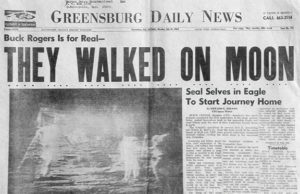 By Robert Reed
By Robert Reed From Apollo mission patches to chunks of rocket ships collectors are increasingly discovering the out-of-the-world appeal of space collectibles.
Space-related things from vintage postcards to signed photographs are attracting followers.
The second edition of Today’s Hottest Collectibles lists space collectibles as one of the more potential fields currently. Included are promotional booklets, media kits, pinback buttons, and training manuals.
In historic terms space exploration and its accompanying memorabilia is not that old. It is generally considered as beginning in the 1950s and highlighted by the launching of Russia’s satellite Sputnik in October of 1957. The decade of the 1960s, considered by some to be the golden period of space launchings, was dominated by American efforts to land a man on the moon.
The United States actually made six lunar landings from the late 1960s into the early 1970s. The first was the Apollo 11 mission and included Neil Armstrong and Buzz Aldrin. Charles Conrad and Alan Bean made it to the moon’s surface in November of 1969. There were two more successful American landings in 1971, and two more in 1972.
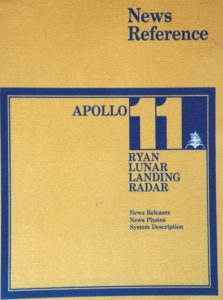 Thus far in all the world history of space exploration only 12 people have actually completed missions of stepping on the surface of the moon and returning to planet earth.
Thus far in all the world history of space exploration only 12 people have actually completed missions of stepping on the surface of the moon and returning to planet earth. Both accomplishments and tragedies following space exploration throughout the 1970s and 1980s including the disaster of the Challenger in 1986. When the Challenger exploded and killed seven astronauts it became the world’s worst space flight disaster. Elsewhere the United States continued massive efforts of unmanned space exploration including Mariner, Pioneer, Viking, and Voyager.
Perhaps the most comprehensive collection of moon mission efforts of the 1960s could be found in a dusty stack of Life magazines. Life was especially generous with is cover coverage of space exploits during that era. Making the coverage in 1962 were John Glenn’s return from space orbit, astronaut Bob White and his son, and the Soviet space capsules.
Later Life magazine featured such events at a rocket lift-off by astronaut Charles Contrad in 1965, a Gemini 10 docking in 1966, and the achievements of astronaut Wally Schirra. Several issues of Life magazine paid tribute to Neil Armstrong and the Apollo 11 mission during the second half of 1969.
A number of other news magazines also gave considerable coverage to the 1960s race to the moon. Among them were Look, Time, and Newsweek. Other periodicals ranging from Aviation Week to TV Guide occasionally focused on space exploration and achievement during that period.
One of the most famous newspaper headlines of the 1960s was variations of Apollo 11’s successful landing on the moon. Most of the surviving 1969 issued had striking banner (clear across the top page) headlines, and are considered significant souvenirs of that event. Also of interest are other newspapers and magazines which highlighted various other Apollo missions, and the activities of Russian astronauts.
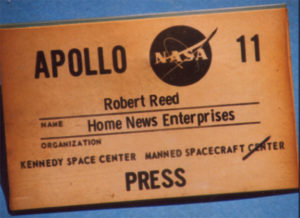 During the summer of 1969 thousands of journalists assembled at Cape Kennedy in Florida for the ‘moonshot’ of Apollo 11. At the time scores of companies who had contributed to the effort distributed colorful media kits. Typically the kits were color illustrated on the front with an assortment of press releases, booklets, and illustrations inside. Very few of the media kits survived the years that followed, and today some distinguished examples are prized.
During the summer of 1969 thousands of journalists assembled at Cape Kennedy in Florida for the ‘moonshot’ of Apollo 11. At the time scores of companies who had contributed to the effort distributed colorful media kits. Typically the kits were color illustrated on the front with an assortment of press releases, booklets, and illustrations inside. Very few of the media kits survived the years that followed, and today some distinguished examples are prized. The gathering of journalists and a throng of tens of thousands of sightseers to the Florida site in July of that year also prompted a flow of maps, tourist guides, site postcards, and regional magazines which centered as well on the legendary moon voyage happening.
Felt pennants were available at both Cape Kennedy and the Johnson Space Center. Some bore the name of the facility, while others proclaimed various space mission accomplishments such as Gemini’s Victory in Space or the Apollo-related America’s Man On the Moon. Apollo mission cloth patches, brightly colored and distinctive, were authorized early on by NASA.
The Apollo missions in general, and the Apollo 11 manned moon landing in particular, generated a great deal of commercial merchandise including banks, books, pin-back buttons, clocks, commemorative plates, and drinking glasses. There were also a number of phonograph records throughout the manned space program including America’s First Man In Orbit (John Glenn) and Man On The Moon (Neil Armstrong).
“Collectors of space memorabilia collect a variety of items,” notes Stuart Schneider, author of Collecting the Space Race one of the few books exclusively on the subject. “But many specialize and collect only a certain category.”
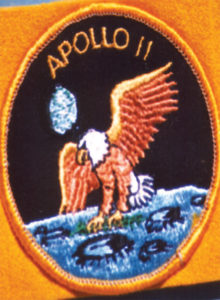 Astronaut autographs is one of those special categories.
Astronaut autographs is one of those special categories. Collectors can choose from hundreds of American and foreign astronauts of the past and present although some can be quite difficult to obtain. Among astronauts of the past some of the most sought are of those who were victims of disasters such as the Apollo 1 crew (Gus Grissim, Roger Chaffee and Ed White) and the Challenger crew (including Mike Smith, Greg Jarvis and Christa McAuliffee).
The world’s number one astronaut, Neil Armstrong, apparently is not handing out autographs. Mark Baker, author of the highly comprehensive Collector’s Guide to Celebrity Autographs, 2nd edition, observes. According to the author Armstrong signed requests in the early days but apparently no longer signs requests and is highly selective in regards to in-person requests.
Still there are lots of space-hero signatures out there according to Baker including clipped signatures, business cards, canceled checks, NASA photographs, books, commemorative envelopes, and posters.
“The options are endless and the rewards are often great,” concludes Baker.
A certain group of space item collectors are ambitious enough to go for material that has actually flown in space. This unique category can be big enough to include parts of space craft as well as space suits and other specific equipment. There are also smaller “flown” items which can include commemorative envelopes, photographs, postcards, other documents, or even moon rocks.
Major auction houses including Sotheby’s and Skinner’s have sold major items of space memorabilia in recent years. A handwritten logbook kept by Russian cosmonaut Yuri Gagari brought $320,000 at one such auction, and a group of small moon rocks fetched $400,000 at another auction.
Recommended reading: Collecting the Space Race by Stuart Schneider (Schiffer Publishing).
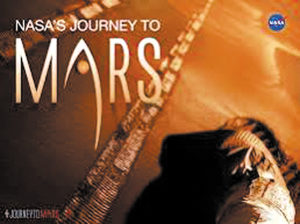 NASA Reaching for Mars Habitization
NASA Reaching for Mars Habitization NASA is under presidential orders to land humans on Mars by 2033, and NASA-funded engineers are studying a way to build potential human habitats there by producing bricks from pressurized Martian soil. The European Space Agency has a long-term goal to send humans but has not yet built a crewed spacecraft.
The Mars mission launching in 2020 would leverage the design of this landing system and other aspects of the Mars Science Laboratory architecture. The Mars 2020 rover mission is part of NASA’s Mars Exploration Program, a long-term effort of robotic exploration of the Red Planet.















Follow Us